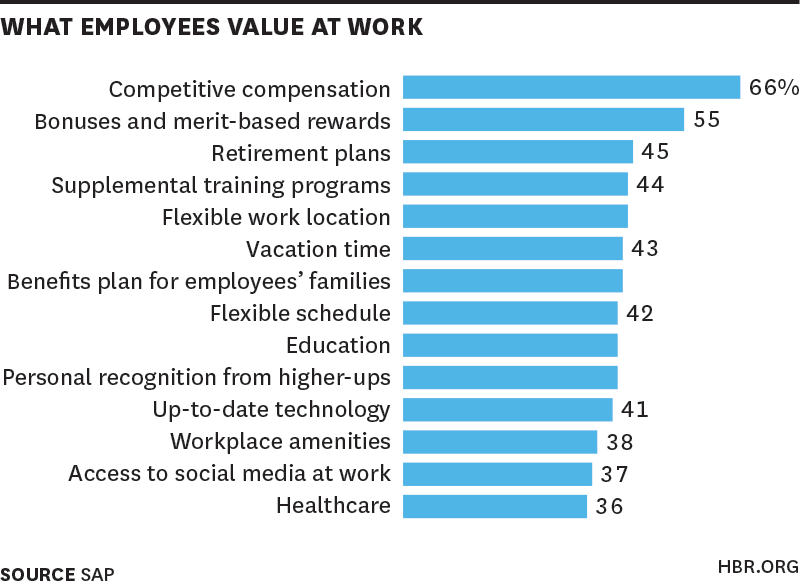Employees value professional development and education within the workplace

Ok, maybe not. But think about an employee who has to “learn on the job” versus one who is well versed in the tasks at hand? The trained professional will spend their workday completing the necessary tasks versus the un-trained individual who has to learn the tools of the trade first.
If you own a business, what type of employee would you rather staff to handle your important tasks? This article is for the small business owners out there who are questioning whether or not the investment in training or professional development is the right move for them.
High Performers get the job done right
In fact, according to a Harvard Business Review study, “a high performer can deliver 400% more productivity than the average performer.” And employees historically value training, as much as anything besides compensation.
This HBR study also verifies that a high performer “as compared to low performers are more satisfied with their jobs and less likely to leave their jobs in the next six months.” Consider the following chart from the same study:
Professional Development paves the way to high performer’s happiness

Let’s try and simplify this even more. If you hire a new employee, there are costs expected to train this person and get them up to speed on their position. As this employee continues at your company, the happier you are able to keep their mental state while at work means that they will be a higher performer.
In turn, a higher performer is less likely to leave which means you don’t have to spend the money to train someone new or start this process over again.
No matter the company or job, every employee wants to feel valued. If you pour your hard work into a job, you want to feel that you are being recognized or rewarded for those efforts. And that typically goes beyond monetary rewards.
If high performers value training and professional development at the top of the list for what they value at work, behind compensation and related, then it makes sense that an employee’s happiness sky rockets from the investment you make as a company into their professional growth.
Consider a recent study done by Sun Microsystems which found that introducing a formal mentorship training program increased retention rates by 23% for participants. In other words, 1 in 4 of your employees that may consider leaving would actually stay if there was some form of mentorship from more experienced employees to those at a younger stage in their career.
This trend is likely to increase, by the way, as Millennials enter the workforce. According to a UNC survey, 65% of Millennials say that the existence of personal development opportunities was the most influential factor in choosing their current job.
Do the math. Yes, training increases productivity and profit

On Capterra, an interview with Andy Grove, one of the founders of Intel explains his reasoning for training at Intel:
Training is, quite simply, one of the highest-leverage activities a manager can perform. Consider for a moment the possibility of your putting on a series of four lectures for members of your department.
Let’s count on three hours of preparation for each hour of course time – twelve hours of work in total. Say that you have ten students in your class.
Next year they will work a total of about twenty thousand hours for your organization. If your training efforts result in a 1 percent improvement in your subordinates’ performance, your company will gain the equivalent of two hundreds hour of work as a result of the expenditure of your twelve hours.
How do we know this to be true in the real world? The American Society of Training and Development (ATSD) released a study backing up this simple truth. Interviewing over 2,500 companies, the ATSD study found that those with comprehensive training programs have:
- 218% higher revenue per employee
- 24% higher profit margins
- A 6% higher shareholder return
The overwhelming value of professional development starts to shine through when you consider the effect on the bottom line as well. With certainty, we can say that, yes, training increases productivity and profit.
Conclusion
Let’s review the path from which training creates a successful workforce. First, training keeps your employees happy. And happy employees are more likely to stay with your company, bring less internal conflicts to your office, and create a successful culture to your workforce.
Happy employees are high performers and high performers spend more time doing the tasks you need them to do to drive more business.
In order to find what training is right for your team, learn more about your employees and determine their preferred style of learning. In your annual reviews, talk about training options or conduct polls of your staff to find out what they desire most.
Understand where the skills gaps in your company currently exist and formulate a plan now to handle those gaps before too many skilled workers are lost. From there, realize that all people learn best in different settings. So, find a hybrid balance of self-paced videos and live training that suits your groups needs.
Finally, continue to explore technology and trends in your industry to keep your workforce happy and empowered to succeed.
Is training worth the investment? If your happy workforce is helping your business succeed, it is an easy question to answer.
Learn more about DWC’s training options – Streaming online, Denver, and Fort Collins


